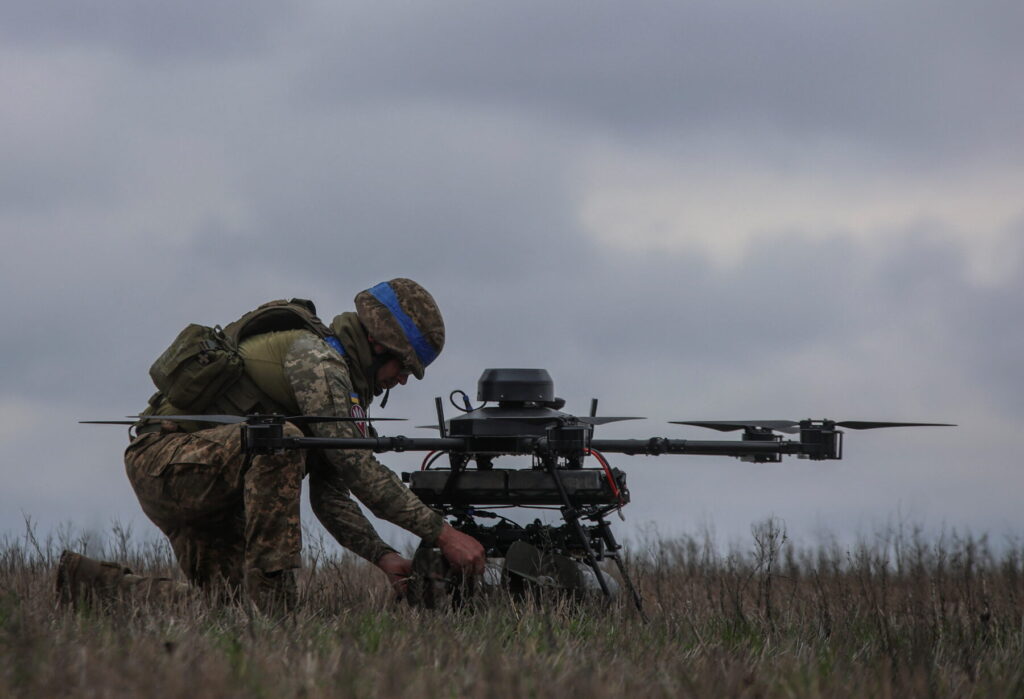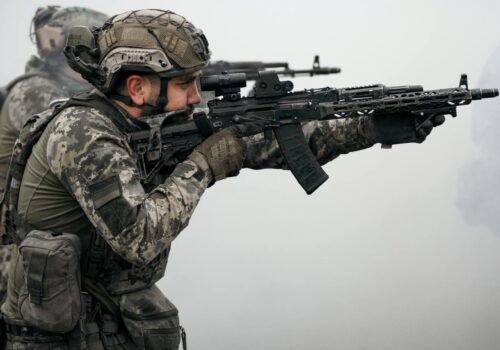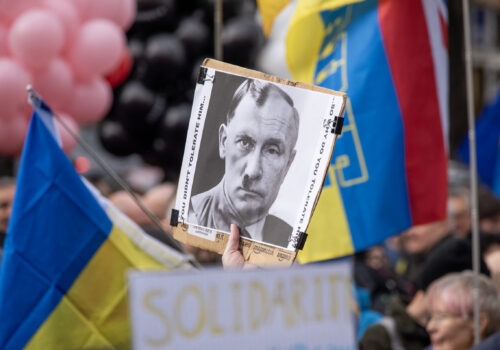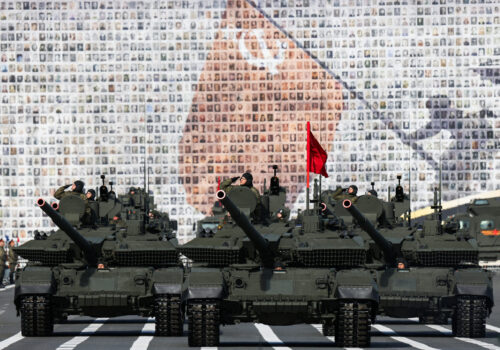Ever since the onset of Russian aggression against Ukraine eleven years ago, military training has been a core element of Western support for the Ukrainian Armed Forces. As Moscow’s invasion has escalated into the largest European war since World War II, the relationship between Ukraine and the country’s partners has become much more of a two-way street. While Ukrainian troops continue to train with Western instructors, it is now increasingly apparent that NATO also has a lot to learn from Ukraine.
The Ukrainian military has evolved dramatically during the past three years of full-scale war against Russia to become the largest and most effective fighting force in Europe. Innovation has played a key role in this process, with Ukraine relying on the country’s vibrant tech sector and traditionally strong defense industry to counter Russia’s overwhelming advantages in terms of both manpower and firepower. This has resulted in an army capable of developing and implementing the latest military technologies at speeds that are unmatched by any Western countries with their far more bureaucratic procurement cycles.
Ukraine’s innovative approach to defense is most immediately obvious in the country’s ability to produce and deploy a wide variety of drones. Since the start of Russia’s full-scale invasion in February 2022, the experience of the Ukrainian army has underlined the growing dominance of drones on the modern battlefield, and has redefined our understanding of drone warfare in ways that will shape military doctrines around the world for many years to come.
Stay updated
As the world watches the Russian invasion of Ukraine unfold, UkraineAlert delivers the best Atlantic Council expert insight and analysis on Ukraine twice a week directly to your inbox.
The most important tools in Ukraine’s unmanned arsenal are the country’s growing fleet of First Person View (FPV) drones. These drones in many ways function as the infantry of drone warfare. They have become a central pillar of Ukraine’s war effort, inflicting up to 80 percent of Russian battlefield casualties and making it possible to hold the line even when Ukrainian troops have found themselves starved of artillery shells.
Ukrainian production of FPV drones has mushroomed in recent years, with domestic companies also gradually moving away from an initial reliance on imported components. By early 2025, Ukraine was reportedly producing 200,000 FPV drones per month. Cheap to manufacture, they are capable of destroying tanks and other military equipment worth millions of dollars.
Russia is also relentlessly adapting to technological changes on the battlefield, creating a daily race to innovate that runs in parallel to the actual fighting on the front lines of the war. The dominance of FPV drones has led to a variety of countermeasures, ranging from the widespread use of netting and so-called “cope cages,” to increasingly sophisticated electronic blocking and the jamming of signals. In response, both Russia and Ukraine are turning to fiber optic drones that are not susceptible to jamming technologies.
As the full-scale war approaches a fourth summer, the evolution of drone tactics continues. Over the past year, Ukraine has sought to establish a 15-kilometer kill zone patrolled by drones along the front lines of the conflict, making it extremely challenging to concentrate troops for major offensive operations. The strength of Ukraine’s so-called “drone wall” defenses will be severely tested in the coming few months by Russia’s ongoing offensive. Building on Ukraine’s experience, NATO is reportedly exploring the idea of creating a “drone wall” of its own on the alliance’s eastern flank.
Beyond the front lines, Ukraine has developed an expanding fleet of long-range drones capable of striking targets deep inside Russia. This has made it possible to carry out a wide range of attacks on Russian military bases, ammunition storage facilities, air defenses, and Putin’s economically vital but vulnerable oil and gas industry. Ukrainian President Volodymyr Zelenskyy has called the country’s growing long range capabilities “a clear and effective guarantee of Ukraine’s security.”
Eurasia Center events

Ukrainian drone innovations are also transforming naval warfare. During the first two years of the war, Ukraine used marine drones to target Russia’s Black Sea Fleet, sinking or damaging multiple warships and forcing the remainder to retreat from Russian-occupied Crimea. This remarkable success made it possible to lift the naval blockade on Ukrainian ports and reopen commercial maritime routes, providing Kyiv with a vital economic lifeline.
More recently, Ukraine has begun using naval drones as launch platforms for missiles and smaller unmanned systems. The results have been spectacular. In January 2025, missile-armed Ukrainian naval drones reportedly destroyed several Russian helicopters over the Black Sea. In another world first, Ukrainian officials announced in early May that they had shot down two Russian fighter jets using marine drones equipped with anti-aircraft missile systems.
Ukrainian military planners are now working on a range of unmanned ground systems as they look to take drone warfare to the next level. With support from the country’s government-backed defense tech cluster Brave1, work is underway to develop dozens of robotic models capable of performing a variety of combat and logistical tasks. In December 2024, Ukrainian forces claimed to have made history by conducting the world’s first fully unmanned assault on Russian positions using ground-based robotic systems and FPV drones.
Speaking in April 2025, Ukraine’s former commander in chief Valeriy Zaluzhniy underlined how his country’s use of new technologies was transforming the battlefield. “The Russian-Ukrainian War has completely changed the nature of warfare,” he commented. Zaluzhniy predicted that the wars of the future would be won by countries that focus their resources on the development of drones, electronic warfare, and artificial intelligence. “It is obvious that victory on the battlefield now depends entirely on the ability to outpace the enemy in technological development,” he noted.
Western leaders and military commanders are clearly taking note of the remarkable progress made by the Ukrainian Armed Forces since 2022. Many are now incorporating Ukraine’s unique battlefield experience into their own programs, while NATO members including Britain and Denmark are reportedly already receiving training in drone warfare from Ukrainian military instructors. This is likely to be just the beginning, as more countries seek to benefit from Ukrainian expertise.
For many years, it has been customary to view Ukraine as being almost entirely dependent on Western aid and know-how for its survival. This was always an oversimplification; it is now hopelessly outdated. In reality, today’s Ukraine is a drone superpower with an innovative domestic defense industry that can provide its NATO allies with important lessons in the realities of twenty-first century warfare.
David Kirichenko is an associate research fellow at the Henry Jackson Society.
Further reading
The views expressed in UkraineAlert are solely those of the authors and do not necessarily reflect the views of the Atlantic Council, its staff, or its supporters.

The Eurasia Center’s mission is to enhance transatlantic cooperation in promoting stability, democratic values, and prosperity in Eurasia, from Eastern Europe and Turkey in the West to the Caucasus, Russia, and Central Asia in the East.
Follow us on social media
and support our work
Image: A Ukrainian serviceman of the 25th Airborne Brigade prepares a Vampire, a heavy unmanned aerial vehicle, for flight near a front line, amid Russia's attack on Ukraine, in Donetsk region, Ukraine April 5, 2025. (REUTERS/Oleksandr Ratushniak)





